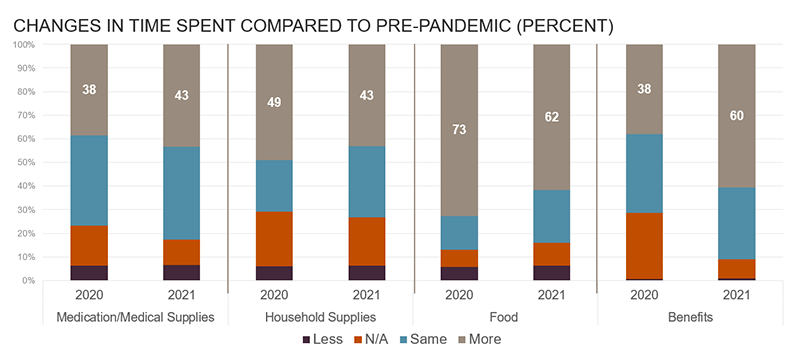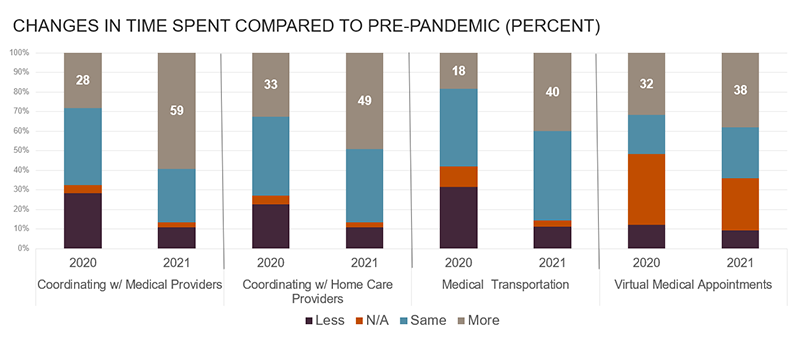Service Coordinators Improved Resident Resilience During the Pandemic
Service coordinators working in federally subsidized, multifamily housing for older adults and people with disabilities drew on their professional knowledge, connections, and relationships to identify and address pandemic-related challenges, according to two surveys we conducted in collaboration with the American Association of Service Coordinators. I discuss the results in "Service Coordination in HUD Housing During the COVID-19 Pandemic: Bridging the Gap," an article I co-authored with Jennifer Molinsky that was recently published in the Journal of Gerontological Social Work.
In June 2020 and November 2021, surveys were sent to roughly 3,500 resident service coordinators working in federally subsidized properties designated for low-income adults 62 and older and people with disabilities. A resident services coordinator is a social worker who monitors resident needs, links them to resources, and coordinates services and benefits.
With 886 and 1175 responses to each survey, we found that the COVID-19 pandemic created barriers to even the most basic resources, including older affordable housing residents’ access to food, medication, medical care, transportation, and social experiences, while simultaneously facilitating a rapid shift in the landscape of public health and benefits program structure and access. Service coordinators were integral to residents and their network of housing service providers, informal supports, professional supports, public resources, and programs. They were able to leverage relationships and institutional knowledge to navigate service gaps and limit pandemic disruptions. In this way, they improved both the efficacy and efficiency of programs and increased resident resilience. In practice, service coordinators managed information by assessing need, identifying resources, and coordinating responses.
Early in the pandemic, service coordinators took on additional roles. One 2020 respondent explained, “since buildings were closed and social workers’/case managers’ visits were very infrequent, I had to become more actively involved with resident well-being.” Typical information flows were interrupted. Properties restricted visitors, staffing shortages limited access to supports, and many community organizations reallocated resources away from typical activities to address sudden community needs. Service coordinators created processes to monitor residents and identify changes in individuals and property-wide conditions.
Survey respondents in 2020 estimated that about one in three residents lacked the food or medication needed to isolate for a week. These pandemic disruptions were especially complicated for older residents with limited economic means to react to changing conditions and who were less likely to have access to the internet which became a lifeline to services, medical providers, and social connections. Underlying health conditions and functional limitations that increase with age also increase reliance on supports that were less available during the pandemic, with respondents in 2022 estimating that access to personal assistance was worse for one third of residents than before the pandemic.
Service coordinators tailored solutions to each property. They repurposed hallways and common spaces to safely engage residents. They nurtured mutual support, organizing phone trees, pen pal programs, and buddy systems, and noted increases in resident inter-reliance. As one described, “if a resident does not have a network of friends, I ask one of my resident volunteers to check-in and call them.” They also facilitated access to public benefits, bridging gaps created when public agencies transitioned to virtual platforms (Figure 1).
Figure 1. Service Coordinators Spent More Time Helping Residents Procure Supplies and Manage Benefits
Service coordinators particularly harnessed the strengths of community organizations, volunteers, and local resources to provide food, medication, supplies, and supportive services. Half of 2021 respondents spent more time working with community-based organizations during the pandemic and over 80 percent were managing a partnership to address food, health or healthcare, and personal care or assistance. More than 4 of 10 organized a new partnership to address nutrition. Service coordinators also collaborated with family members, communicating new property access rules and relaying emerging needs. Additionally, they managed volunteers from the community.
Service coordinators also built capacity for residents to use new technology as the pandemic changed how residents accessed and interacted with medical professionals. By the 2021 survey, respondents estimated that half of residents accessed more virtual healthcare than before the pandemic and two-thirds used more virtual mental healthcare (Figure 2).
Figure 2. Service Coordinators Spent an Increasing Amount of Time Supporting Professional Healthcare in 2021
Well over half of 2021 respondents spent more time developing and organizing device lending and technology literacy programs to ensure residents could access the internet and internet-capable devices. Technology access improved through these efforts, but 2021 respondents still estimated that only half of older residents had internet access plus an internet capable device, up from 38 percent in 2020. Inadequate internet access was compounded by reduced access to transportation.
During the pandemic, limited social contact took a toll on many residents with 2021 respondents estimating that 65 percent of residents had less social interaction than pre-pandemic. Even in late-2021, when vaccinations were available and social distancing restrictions had been relaxed, service coordinators assessed that 55 percent of residents showed more signs of loneliness and anxiety than before the pandemic. Respondents in 2021 described resident behavior that looked like depression, hoarding, disordered substance use, and even suicidal ideology or attempts. As one noted, “mental health issues caused from isolation…are not addressed. No services available for this group unless suicidal.” Service coordinators also expressed concern for resident physical health. In 2021, they estimated that 53 percent of older residents had worse physical health than before the pandemic and 62 percent were getting less exercise.
While acute pandemic impacts are behind us, service coordinators continue to help residents navigate both individual and macro-level disruptions, ranging from new health diagnoses and the loss of a spouse, to unexpected emergencies such as fire or weather events. Yet service coordination is not consistently available across HUD-funded properties that house older and disabled residents. Additional study is needed to understand the deficits experienced by residents who navigated the pandemic without access to a service coordinator so that we might better assess the current patchwork funding available to meet the needs of residents experiencing a disruption.
To learn more, join us virtually at 12:15pm ET today, November 18, for a discussion of service coordination during the pandemic: Helping Older Americans During the Pandemic: The Role of Service Coordinators.



